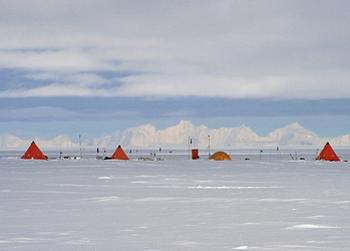
NEWCASTLE UPON TYNE, UK, January 15, 2014 (ENS) – A massive ancient subglacial trough, deeper than the Grand Canyon in the United States, has been discovered far beneath the ice of West Antarctica.
A team of UK experts charted the Ellsworth Subglacial Highlands, a mountain range buried beneath several kilometers of ice, by combining data from satellites and ice-penetrating radars towed behind skidoos and on-board small aircraft.

The paper’s lead author is Dr. Neil Ross, a lecturer in physical geography at Newcastle University. “The discovery of this huge trough, and the characterization of the surrounding mountainous landscape, was incredibly serendipitous,” he said, announcing the discovery on Tuesday.
“We had acquired ice penetrating radar data from both ends of this huge hidden valley, but we had no information to tell us what was in between. Satellite data was used to fill the gap, because despite being covered beneath several kilometers of ice, the valley is so vast that it can be seen from space.”
The research involved scientists from Newcastle University, the University of Bristol’s Glaciology Centre, the British Antarctic Survey and the universities of Edinburgh, Exeter, and York.
The scientists spent three seasons investigating and mapping the region, uncovering a massive subglacial valley up to three kilometers deep, more than 300 kilometers long and up to 25 kilometers across.

In places, the floor of this valley is more than 2,000 meters below sea level.
“We document well-preserved classic landforms associated with restricted, dynamic, marine-proximal alpine glaciation, with hanging tributary valleys feeding a significant overdeepened trough (the Ellsworth Trough) cut by valley (tidewater) glaciers,” the researchers write.
The scientists determined that the mountain range and deep valley were carved millions of years ago by a small icefield similar to those of the present-day Antarctic Peninsula, or those of Arctic Canada and Alaska.
“The landscape predates the present ice sheet and was formed by a small dynamic ice field(s), similar to those of the present-day Antarctic Peninsula, at times when the marine sections of the West Antarctic Ice Sheet were absent,” the authors explain in their paper.
The team’s analysis has provided an unprecedented insight into the extent, thickness and behavior of this ancient icefield, and the configuration and behavior of the early West Antarctic Ice Sheet.
The subglacial landscape shows where and how the West Antarctic Ice Sheet originated and grew. It also provides important clues about the size and shape of the ice sheet in West Antarctica in a warmer global climate.
“The Ellsworth Subglacial Highlands represent a major seeding center of the paleo-West Antarctic Ice Sheet, and its margins represent the pinning point at which future retreat of the marine-based West Antarctic Ice Sheet would be arrested,” the authors explain.
“To me,” said Ross, “this just goes to demonstrate how little we still know about the surface of our own planet. The discovery and exploration of hidden, previously-unknown landscapes is still possible and incredibly exciting, even now.”
The research findings are published in the latest edition of the “Geological Society of America Bulletin.”
Copyright Environment News Service (ENS) 2014. All rights reserved.
© 2014, Environment News Service. All rights reserved. Content may be quoted only with proper attribution and a direct link to the original article. Full reproduction is prohibited.
